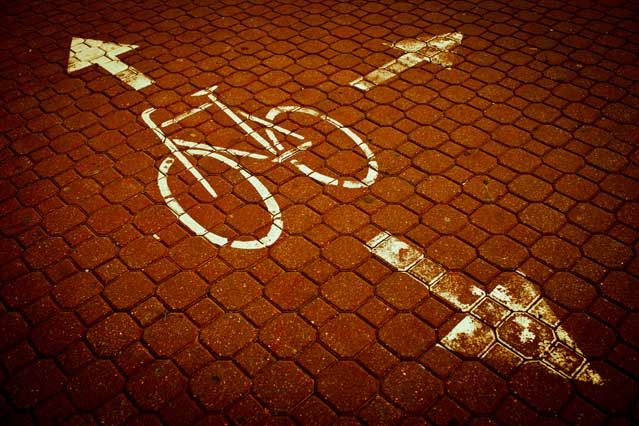It was 8:20 a.m on a Tuesday. I was biking south down 11th Street in Washington, D.C., during the morning rush hour. Up ahead, half a dozen cyclists were stopped at the U Street intersection, waiting for the light to change. As I took my place at the back of the disorganized pack, a guy riding a bright red Capital Bikeshare rig and wearing a thin black suit with a pink tie flanked my left side, passing close enough for me to get a whiff of his Old Spice. When he reached the head of the crowd, he attempted to bring the 42-pound bike to a standstill without removing his feet from the pedals. He teetered awkwardly, swung his handlebars wildly, almost fell left into the opposite lane, and then crashed into the cyclist to his right, who naturally fell to his right, into another cyclist.
That domino crash was one of the more ridiculous bike-on-bike accidents I’ve seen in over ten years of biking, but I’ve witnessed near-endless litany of idiotic cycling behavior. In that time, two things have become increasingly clear: urban biking is on the rise, and there are more clueless cyclists on the road now than there has ever been.
Every serious commuter has had the moment when they realized that urban cycling has started to go mainstream. For me, that moment came in 2009, when Urban Outfitters started selling custom single speeds online and GQ magazine’s Sartorialist recommended equestrian helmets as the most fashionable alternative to bike helmets. Immediately, I started to pay attention.
Bike riding in the nation’s capital has grown 80 percent from 2007 to 2010, buoyed by bike-friendly streets and an increase in dedicated bike lanes. A similar increase has occurred around the country; a 2011 survey conducted by The Atlantic found regular bike commuters in 55 major U.S. cities from 2000 to 2009. In D.C., when Alta Bike Share launched the program in September 2010 with 49 bike stations, bike riding went into overdrive. Today the program boasts 110 stations and 1,100 bikes—with 25 new stations coming in early 2012. Paris, Melbourne, and London have similarly successful programs, and both and NYC are slated to launch bike shares in 2012. With this civic encouragement, the number of blissfully unaware bikers will expand exponentially, leaving riders like me worrying not only about crazy drivers, careening busses, jaywalking pedestrians, glass-strewn side streets, and potholes—but the clueless as well.
I don’t care if you’re swaddled in enough latex to conquer Alpe d’Huez or wearing jeans tight enough to reveal the colorful waistband of your worn boxer briefs, I just ask that you know how to ride. Right now there are too many people on the streets who think that cycling should be as easy and carefree as it was when you were a kid. It’s not that I want you to get off the streets; studies have shown an increase in the number of bike commuters actually leads to a . I just want you to follow a few basic rules. To that end, here a few tips to keep all of us safe in the saddle.
First and foremost, act like you’re in traffic. That means no head phones on your ears and no Starbucks in your hands. If you get a phone call, don’t answer—or stop before you answer it. The same goes for texting, which should go without saying, but apparently needs to be screamed in bold text. This past winter, the city of Chicago , putting in place fines ranging from $20 to $500.
If you do need to stop your bike, don’t stand in other cyclists’ line. Other cyclists are your allies, but don’t cut them off or try to draft behind them in an effort to slingshot through a yellow light. Know your pecking order. Don’t stand front and center in pack of commuting cyclists if you’re not going to be the first off the line when the light changes.
If you’re bold enough to go the wrong way down a one-way street, yield to the cyclists going the right way. Also, make yourself visible at night. Cross-guard vests may qualify as gear overkill, but blinking tail and head lights help other riders see you. Wear a helmet. Your vanity shouldn’t trump the fact that weren’t wearing them.
And please, stay off the sidewalks. Last month I saw an army of tourists on bikes who corralled a group of pedestrians into a near-collusion with a Metro bus. Sidewalks are the sole domain of the pedestrian, at least until you reach your destination.
Lastly, get used to biking when the streets aren’t frenzied before you start commuting during rush hour. Go on a cruise on a dedicated bike path. Learn the bike’s weight and turn radius. Figure out how to come to a complete stop without tipping over. Then edge into the urban realm with off-hour rides on weekends and when traffic is light on weekdays. Eventually , you’ll be ready to blend into the chaos of daily commuting. Lucky for you, late winter is a great time to get used to biking; the number of bikes on the street drops as much as 60 percent. Check into classes. For example, the offers everything from adult learn-to-ride classes to seminars on commuting and confident city cycling.
“We need new cyclists to know that they don’t know enough about biking in the city,” says Daniel Hoagland, DC Bike Ambassador and Coordinator with WABA. “You need to think like a cyclist, not a motorist or a pedestrian.”


